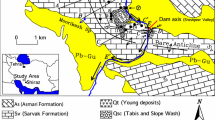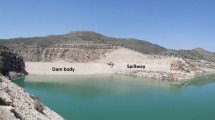Abstract
The Doosti Dam, with a reservoir capacity of 1,250 million cubic meters, was constructed on the Harirood River at the border of Turkmenistan and Iran. The reservoir is in direct contact with permeable formations on the right abutment of the dam including the Neyzar Sandstone, the Kalat Limestone and the Pesteleigh alternative layers of marlstone and sandstone. After the reservoir impoundment, several new springs and seepages emerged from these formations and the alluvium. The amount of leakage increased with the rise in reservoir water level. Fifteen kilograms of sodium fluorescein were injected into a 113-m deep borehole intersecting three permeable sandstone layers of the Pesteleigh formation. Dye was detected downstream of the grout curtain in boreholes and springs that were in direct contact with parts of the Pesteleigh formation having the same sandstone layers as the injection borehole. The dye velocity was in the range of diffuse flow, confirming the good performance of the grout curtain in the Pesteleigh formation. No dye was detected in the other formations because the injection borehole was not in direct contact with these formations. The hydraulic relation of the other formations with the reservoir was determined by considering direct contact of the formations with the reservoir, emergence of new springs and seepages after reservoir impoundment, correlation of time variations of the springs discharge and the borehole’s water level with the reservoir water level, and in some cases the hydrochemistry of the water. The results show that the Kalat and Neyzar formations are hydraulically connected to the reservoir, but the small amounts of leakage from these formations at a hydraulic gradient of 24% indicates good performance of the built grout curtain. The total reservoir leakage at maximum reservoir water level was 100 l/s which is insignificant compared with the 15 m3/s average annual release of the reservoir.




















Similar content being viewed by others
References
Afshar-Harb A (1979) The stratigraphy, tectonics and petroleum geology of Kopet Dagh region, northern Iran. Ph. D. Thesis, Petroleum Geology Section, Royal School of Mines, Imperial College, London, pp 316
Aley T (1975) A predictive hydrological model for evaluating the effect of land use on the quantity and quality of water from Ozark Spring. Ozark Laboratory, Missouri
ASTM (1998) Standard Guide for Design of Ground-Water Monitoring System in Karst and Fractured -Rock Aquifers. American Society for Testing and Material: D 5717-95
Bakalowicz M (1973) Les Grandes manifestations hydrologiques des karsts dans le monde. Spelunca 2:38–40
Berberian M, King GCP (1981) Towards a paleogeography and tectonic evolution of Iran. Can J Earth Sci 18:210–265
Eftekharnejad J, Behroozi A (1991) Geodynamic significance of recent discoveries of ophiolites and late paleozoic rocks in NE Iran (including Kope Dagh). Abhandlungen der Geologischen Bundesanstalt 38:89–100
Ford DC, Williams PW (1989) Karst geomorphology and hydrology. Unwin Hymam, London, p 601
Hollingsworth J, Jackson J, Walker R, Gheitanchi MR, Bolourchi MJ (2006) Strike-slip faulting, rotation and along-strike elongation in the Kopeh Dagh Mountains, NE Iran. Geophys J Int 166:1161–1177
Klimchouk AB, Ford DC, Palmer AN, Dreybrodt W (2000) Speleogenesis: evolution of Karst Aquifers. Published by the National Speleogical Society, Inc, Alabama
Kruse PB (1980) Karst investigation of Maligne basin, Jasper National Park, Alberta. MSc Thesis, University of Alberta, Canada
Lee JY, Kim HS, Choi YK, Kim JW, Cheon JY, Yi MJ (2007) Sequential tracer test for determining water seepage paths in a large rockfill dam, Nakdong River Basin, Korea. Eng Geol 89:300–315
Milanovic PT (1981) Karst hydrogeology. Colorado Water Resources Publication
Milanovic PT (2000) Geotechnical engineering in karst. Zebra Publishing Ltd., Belgrade, pp 347
Mohammadi Z, Raeisi E, Zare M (2007) A dye-tracing test as an aid to studying karst development at an artesian limestone sub-aquifer: Zagros Zone, Iran. Environ Geol 52:587–594
Mozafari M, Raeisi E, Zare M, Mohammadi Z, Bahadori F (2008) Path and velocity of water flow in the Doosti dam using dye tracer, 26th symposium of geosciences. Geological Survey of Iran (GSI), Tehran, Iran (in Persian)
Raeisi E, Aghdam J, Zare M, Karimi H (2005) Study of karst development and possible leakage from the Sazbon Dam, Iran. In: Proceeding of 14th international congress of speleology, Athens
Ramazani Oomali R, Shahriari S, Hafezi Moghaddas N, Omidi P, Eftekharnejhad J (2008) A model for active tectonics in Kope Dagh (North-East Iran). World Appl Sci J 3(2):312–316
Stocklin J (1968) Structural history and tectonics of Iran: a review. Am Assoc Petroleum Geol Bull 52(7):1229–1258
Stocklin J, Setudehnia A (1977) Stratigraphic lexicon of Iran. G. S. I. Report No. 18, 376
Tchalenko JS (1975) Seismocity and structure of the Kopeh Dagh (Iran, USSR) Landon. A.G.B.DA. (1975): 278 (1275): 1–28
Thomas HH (1978) The engineering of large dams. Wiley, London, pp 192–209
Toosab Consulting Engineering (1999) Doosti Dam Engineering Geology Report. Ministry of Water and Land Reclamation of the Republic of Turkmenistan, and Khorasan Regional Water Board of the Islamic Republic of Iran, pp 78
Turkmen S, Özgüler E, Taga H, Karaogullarindan T (2002) Seepage problems in the karstic limestone foundation of the Kalecik Dam (south Turkey). Eng Geol 63:247–257
Uromeihy A (2000) The Lar Dam; an example of infrastructural development in a geologically active karstic region. J Asian Earth Sci 18:25–31
Williams PW (1977) Hydrology of the Waikoropupu Springs: a major tidal karst resurgence in northwest Nelson (New Zealand). J Hydrol 35:73–92
Zamani B, Angelier J, Zamani A (2008) State of stress induced by plate convergence and stress partitioning in northeastern Iran, as indicated by focal mechanisms of earthquakes. J Geodyn 45:120–132
Acknowledgments
The authors gratefully appreciate the sincere cooperation of the Ministry of Water and Land Reclamation of the Republic of Turkmenistan, and Khorasan Regional Water Board of the Islamic Republic of Iran during the field study. Thanks are also due to the Koolham Construction Company and the Toossab Consulting Engineers for providing facilities and technical information. We acknowledge Shiraz University for providing the facilities and the leave time to work on this research project.
Author information
Authors and Affiliations
Corresponding author
Rights and permissions
About this article
Cite this article
Mozafari, M., Raeisi, E. & Zare, M. Water leakage paths in the Doosti Dam, Turkmenistan and Iran. Environ Earth Sci 65, 103–117 (2012). https://doi.org/10.1007/s12665-011-1069-x
Received:
Accepted:
Published:
Issue Date:
DOI: https://doi.org/10.1007/s12665-011-1069-x




